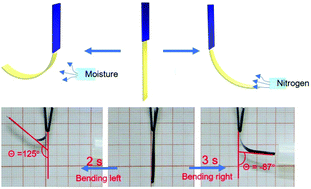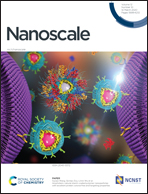Water transport facilitated by carbon nanotubes enables a hygroresponsive actuator with negative hydrotaxis†
Abstract
Hygroresponsive actuators harness minor fluctuations in the ambient humidity to realize energy harvesting and conversion, thus they are of profound significance in the development of more energy-saving and sustainable systems. However, most of the existing hygroresponsive actuators are only adaptive to wet environments with limited moving directions and shape morphing modes. Therefore, it is highly imperative to develop a hygroresponsive actuator that works in both wet and dry environments. In this work, we present a bidirectional actuator responsive to both wet and dry stimuli. Our strategy relies on the introduction of carbon nanotubes to provide transport channels for water molecules. The actuation is enabled by the rapid transport of water in and out of the system driven by the moist/dry surroundings owing to the transport channels. The resultant actuator demonstrates reconfiguration and locomotion with turnover frequency F = 30 min−1, coupled with the capability of lifting objects 6 times heavier and transporting cargos 63 times heavier than itself. Oscillations (24°) driven by dry air flow in a cantilever display a high frequency (2 Hz) and large amplitude. Furthermore, a touchless electronic device was constructed to output varying signals in response to humid and dry environments. Our work provides valuable guidance and implications for designing and constructing hygroresponsive actuators, and paves the way for next-generation robust autonomous devices to exploit energy from natural resources.



 Please wait while we load your content...
Please wait while we load your content...